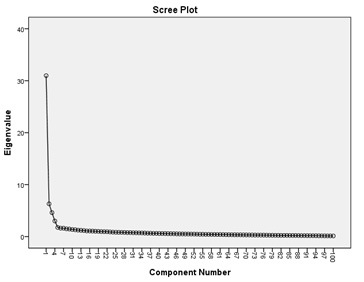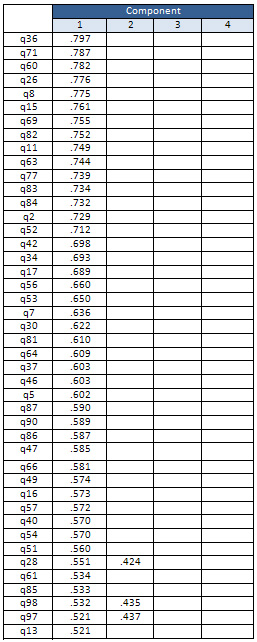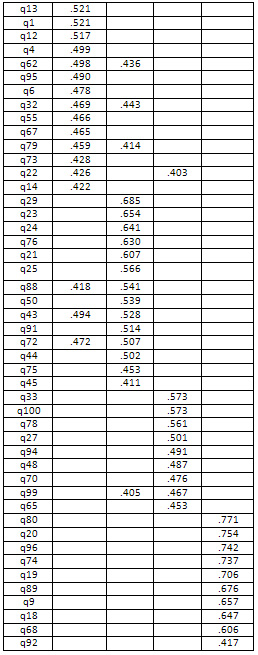|
|
 |
| ............................................................. |
|
|
| ........................................................ |
| From
the Editor |

|
Editorial
A. Abyad (Chief Editor) |
........................................................
|
|
Original contribution/Clinical Investigation
Diabetes Mellitus
- Knowledge, Management and Complications: Survey
report from Faisalabad-Pakistan
Ijaz Anwer, Ahmad Shahzad, Kashmira Nanji, Farah
Haider, Muhammad Masood Ahmad
Alanine aminotransferase
indicates excess weight and dyslipidemia
Mehmet Rami Helvaci, Orhan Ayyildiz* Mustafa
Cem Algin, Yusuf Aydin, Abdulrazak Abyad, Lesley
Pocock
Comparative Analysis of Antimicrobial Peptides
Gene Expression in Susceptible/Resistant Mice
Macrophages to Leishmania major Infection
Hamid Daneshvar, Iraj Sharifi, Alireza Kyhani,
Amir Tavakoli Kareshk, Arash Asadi
Does
socio-economic status of the patients have effect
on clinical outcomes after coronary artery bypass
grafting surgery?
Forough Razmjooei, Afshin Mansourian, Saeed
Kouhpyma
Comparison of the uterine
artery Doppler indices during pregnancy between
gestational diabetes and diabetes mellitus and
healthy pregnant women
Nazanin Farshchian, Farhad Naleini, Amir Masoud
Jaafarnejhad,
Parisa Bahrami Kamangar
Survey single dose
Gentamicin in treatment of UTI in children with
range of 1 month to 13 years old in Jahrom during
2015
Ehsan Rahmanian, Farideh Mogharab,
Vahid Mogharab
Evaluation of control of
bleeding by electro cauterization of bleeding
points of amplatz sheath tract after percutaneous
nephrolithotomy (PCNL) in Jahrom Peymanieh hospital
during year 2015-2016
Ali Reza Yousefi , Reza Inaloo
Comparison of the three-finger
tracheal palpation technique with triple ID
formula to determine endotracheal tube depth
in children 2-8 years in 2016-2017
Anahid Maleki, Alireza Ebrahim Soltani, Alireza
Takzare, Ebrahim Espahbodi,
Mehrdad Goodarzi , Roya Noori
Effect of Sevoflurane
and Propofol on pulmonary arterial pressure
during cardiac catheterization in children with
congenital heart diseases
Faranak Behnaz, Mahshid Ghasemi , Gholamreza
Mohseni, Azim Zaraki
Population and Community Studies
Prevalence
and risk factors of obesity in children aged
2-12 years in the Abu Dhabi Islands
Eideh Al-Shehhi, Hessa Al-Dhefairi, Kholoud
Abuasi, Noora Al Ali, Mona Al Tunaiji, Ebtihal
Darwish
Study and comparison
of psychological disorders in normal students
and students with multiple sclerosis in Shahrekord
Neda Ardestani-Samani, Mohammad Rabiei, Mohammad
Ghasemi-Pirbalooti, Asghar Bayati, Saeid Heidari-Soureshjani
Comparative
study of self-concept, physical self-concept,
and time perspective between the students with
multiple sclerosis and healthy students in Shahrekord
Neda Ardestani-Samani, Mohammad Rabiei, Mohammad
Ghasemi-Pirbalooti, Asghar Bayati, Saeid Heidari-Soureshjani
Relationship
between Coping Styles and Religious Orientation
with Mental Health in the Students of the Nursing-Midwifery
Faculty of Zabol
Nasim Dastras, Mohsen Heidari Mokarrar, Majid
Dastras, Shirzad Arianmehr
Tuberculosis in Abadan,
Iran (2012-2016): An Epidemiological Study
Ali-Asghar ValiPour, Azimeh Karimyan, Mahmood
Banarimehr, Marzieh Ghassemi, Maryam Robeyhavi,
Rahil Hojjati,
Parvin Gholizadeh
Family Stability and Conflict
of Spiritual Beliefs and Superstitions among
Yazdi People in Iran: A Qualitative Study
Zahra Pourmovahed , Seyed Saied Mazloomy Mahmoodabad
; Hassan Zareei Mahmoodabadi ; Hossein Tavangar
; Seyed Mojtaba Yassini Ardekani ; Ali Akbar
Vaezi
A comparative
study of the self-actualization in psychology
and Islam
Simin Afrasibi, Zakieh Fattahi
The effectiveness
of cognitive - behavioral therapy in reducing
the post-traumatic stress symptoms in male students
survivors of earthquake in the central district
of Varzeghan
Sakineh Salamat, Dr.Ahad Ahangar, Robab Farajzadeh
Reviews
Effects and mechanisms
of medicinal plants on stress hormone (cortisol):
A systematic review
Kamal Solati, Saeid Heidari-Soureshjani, Lesley
Pocock
Comparing Traditional
and medical treatments for constipation : A
Review Article
Mohammad Yaqub Rajput
A review of anti-measles
and anti-rubella antibodies in 15- 25 year old
women in Jahrom City in 2011
Ehsan Rahmania , Farideh Mogharab, Vahid Mogharab
Review of percutaneous
nephrolithotomy in children below 12 years old
in Jahrom hospital, during 2010-2014
Ali Reza Yousefi , Reza Inaloo
Physical and
mental health in Islam
Bahador Mehraki, Abdollah Gholami
International Health Affairs
The Challenges of Implementation
of Professional Ethics Standards in Clinical Care
from the viewpoint of Nursing Students and Nurses
Saeedeh Elhami, Kambiz Saberi, Maryam Ban, Sajedeh
Mousaviasl, Nasim Hatefi Moadab, Marzieh Ghassemi
Cognitive Determinants
of Physical Activity Intention among Iranian Nurses:
An Application of Integrative Model of Behavior
Prediction
Arsalan Ghaderi, Firoozeh Mostafavi, Behzad Mahaki,
Abdorrahim Afkhamzadeh,
Yadolah Zarezadeh , Erfan Sadeghi
Effect of resilience-based
intervention on occupational stress among nurses
Hossein Jafarizadeh, Ebrahim Zhiyani, Nader
Aghakhani, Vahid Alinejad, Yaser Moradi
Education and Training
Calculation of Salaries
and Benefits of Faculty Members in the Ministry
of Health and Medical Education of Iran
Abdolreza Gilavand
The effect of education
on self-care behaviors of gastrointestinal side
effects on patients undergoing chemotherapy
Shokoh Varaei, Ehsan Abadi Pishe, Shadan Pedram
Razie, Lila Nezam Abadi Farahani
Creating and
Validating the Faith Inventory for Students
at Islamic Azad University of Ahvaz
Solmaz Choheili, Reza Pasha, Gholam Hossein
Maktabi, Ehsan Moheb
Creating
and Validating the Adjustment Inventory for
the Students of Islamic Azad University of Ahvaz
Homa Choheili, Reza Pasha, Gholam Hossein Maktabi,
Ehsan Moheb
Evaluating
the Quality of Educational Services from the
Viewpoints of Radiology Students of Ahvaz Jundishapur
University of Medical Sciences
Abdolreza Gilavand, Jafar Fatahiasl
An Investigation
of Psychosocial aspect of Iranian Nursing Students'
Clinical Setting
Mahsa Boozaripour , Zanyar Karimi, Sima Zohari
Anbohi, Amir Almasi-Hashiani, Fariba Borhani
Clinical Research and Methods
Comparison of the
Antibacterial Effects of Chlorhexidine Mouth
washes with Jaftex Mouth wash on Some Common
Oral Microorganisms (An in Vitro Study)
Ebrahim Babadi, Zahra Bamzadeh, Fatemeh Babadi
Study of the effect
of plasma jet on Fusarium isolates with ability
to produce DON toxins
Elham Galin Abbasian, Mansour Bayat, Arash chaichi
Nosrati, Seyed Jamal Hashemi, Mahmood Ghoranneviss
The comparison of
anti-inflammatory effect in two methods of topical
dexamethasone injection and topical application
of ginger alcoholic extract after removing mandibular
wisdom teeth
Sahar Zandi, Seyyed Muhammadreza Alavi, Kamran
Mirzaie, Ramin Seyedian, Narges Aria, Saman
Jokar
The effect of curcumin
on growth and adherence of major microorganisms
causing tooth decay
Leila Helalat, Ahmad Zarejavid, Alireza Ekrami,
Mohammd Hosein Haghighizadeh, Mehdi Shiri Nasab
|
|
Chief
Editor -
Abdulrazak
Abyad
MD, MPH, MBA, AGSF, AFCHSE
.........................................................
Editorial
Office -
Abyad Medical Center & Middle East Longevity
Institute
Azmi Street, Abdo Center,
PO BOX 618
Tripoli, Lebanon
Phone: (961) 6-443684
Fax: (961) 6-443685
Email:
aabyad@cyberia.net.lb
.........................................................
Publisher
-
Lesley
Pocock
medi+WORLD International
11 Colston Avenue,
Sherbrooke 3789
AUSTRALIA
Phone: +61 (3) 9005 9847
Fax: +61 (3) 9012 5857
Email:
lesleypocock@mediworld.com.au
.........................................................
Editorial
Enquiries -
abyad@cyberia.net.lb
.........................................................
Advertising
Enquiries -
lesleypocock@mediworld.com.au
.........................................................
While all
efforts have been made to ensure the accuracy
of the information in this journal, opinions
expressed are those of the authors and do not
necessarily reflect the views of The Publishers,
Editor or the Editorial Board. The publishers,
Editor and Editorial Board cannot be held responsible
for errors or any consequences arising from
the use of information contained in this journal;
or the views and opinions expressed. Publication
of any advertisements does not constitute any
endorsement by the Publishers and Editors of
the product advertised.
The contents
of this journal are copyright. Apart from any
fair dealing for purposes of private study,
research, criticism or review, as permitted
under the Australian Copyright Act, no part
of this program may be reproduced without the
permission of the publisher.
|
|
|
| November 2017
- Volume 15, Issue 9 |
|
|
Creating and Validating
the Faith Inventory for Students at Islamic
Azad University of Ahvaz
Solmaz Choheili (1)
Reza Pasha (2)
Gholam Hossein Maktabi (3)
Ehsan Moheb (4)
(1) MA in Educational Psychology, Department
of Psychology, Ahvaz Branch, Islamic Azad University,
Ahvaz, Iran
(2) Department of Psychology, Ahvaz Branch,
Islamic Azad University, Ahvaz, Iran
(3) Department of Psychology, Shahid Chamran
University of Ahvaz, Ahvaz, Iran
(4) Phd in Educational Psychology, Department
of Educational Psychology, Shahre-kord Branch,
Islamic Azad University, Shahre-kord, Iran
Corresponding author:
Reza Pasha
Department of Psychology, Ahvaz Branch, Islamic
Azad University,
Ahvaz, Iran
Email: g.rpasha@yahoo.com
|
Abstract
This
study aimed to develop and validate the
faith inventory. A sample of 736 students
of Islamic Azad University of Ahvaz was
selected by multi-stage random sampling
method and a faith inventory with 100
items was used to measure their faith.
Each item was based on the five-point
Likert scale from Not fully used to Fully
used. After collecting data, the correlation
of each item with the total score was
calculated. The Cronbach’s Alpha
coefficient for the 100-item set was 0.967;
after eliminating 10 items for a set of
90 questions, it was 0.996. Factor analysis
was used to verify the construct validity
of the inventory; the KMO value as a measure
of sampling adequacy was 0.958 and the
significance of the Bartlett’s sphere
test indicated that there were suitable
conditions for implementing factor analysis.
After removal of inappropriate questions
with a factor load of less than 0.3, based
on the analysis of principal components
and varimax rotation, according to the
factor matrix, gradient diagram and the
percentage of variance explained, four
factors were extracted from a set of 90
questions, explaining 44.87% of the total
variance among the variables. The first
factor with 57 items and the special value
of 30.97 covers about 69.02% of the total
variance of the variables and is an indicator
of belief/certainty; the second factor
with 14 items indicatesjustice, the third
factor with nine items, shows the Jihad
and the fourth factor with 10 items measures
the patience.
Key words:
Faith, Validity, Inventory, Narration
|
Faith and religious beliefs in Iranian society
are considered as the main pillars of life and
over the three last decades, religious teachings
have been particularly emphasized (1). Faith
refers to any type of principle, guidance, belief,
certainty or tendency that makes life meaningful
and purposeful (2). No decent psycho-inventoryist
- even a non-religious one - can ignore the
importance of religion, faith, and religious
beliefs in the process of psychotherapy, mental
health, meaningfulness of life, psycho-inventoryical
well-being, and so on (3). The results of psychoinventoryical
studies have shown that children who have been
trained by strongly religious teachings before
adolescence and adulthood, question their religious
beliefs and nearby people in their adulthood.
This is due to the fact that human thinking
grows, and rapid cognitive development makes
it easier for them to judge on matters of value
and religion and to react more precisely and
complicatedly to these issues (4, 5). Adults
are at the highest risk of poverty and neglect
of human values and diminished faith and should
be placed as priority in psychological studies
of value and religion. Considering that until
now, research on recognition of the faith periods
based on the stages of development have been
less considered, conducting a study that can
providea scientific basis for the design and
examination of the concept of faith of people
in a particular cultural area based on the process
of transforming concepts, is seriously needed.
This first and foremost requires the need for
accurate, valid and reliable tools for obtaining
strong results.
Fowler (6) does not present a comprehensive
definition of faith and only summarizes some
of the characteristics of faith: “Faith
is an inclusive thing in all human beings. We
have been equipped with the capacity of faith
from birth”. He focuses on the two characteristics
of faith: universality and fundamentality: “Faith
is so fundamental that no human being can live
well without having it for a long time, and
it is so comprehensive, namely when we slowly
present symbols, slogans, or moral patterns,
we express our faith. Clear faith is the only
common phenomenon in all religions, the Christians,
Marxists, Hindus, and Dinka (Ekman, 1995). Fowler
(6) regards faith as a general conception and
states: “Faith is a puzzle that is not
easy to understand.”
Man’s orientation or reaction to himself,
others, and the universe is called belief (7).
Faith reflects human talent in seeing and feeling;
the transcendent dimension and corresponding
behavior reflects its capacity in the perception
of meaning beyond materiality. In other words,
faith is any kind of principle and guidance,
belief and certainty, which gives meaning to
one’s life and directs it and as a way
of life originates from human nature (Mohammadzadeh,
2005).
Fowler (6) presents theory of faith, with a
perceptual model about the effects of faith.
This theory has raised the concept of faith,
its relation to life, the goals of humanity,
and the sense of creating meaning in life. According
to Fowler (8), the theory of faith shows the
way people understand faith throughout life.
The development of measurement methods and new
psychometric theories have led to the emergence
of new scholarly methods for assessing the talents,
abilities and other psychometric characteristics
of individuals that have been considered by
the instructors, consultants, psychologists
and other behavioral science experts. Although
a number of instruments have been developed
for measurement of religious tendencies and
similar subjects, limited research has been
carried out on the measurement of faith due
to its newness. Because this tool (inventory)
is designed to measure students’ faith,
it is necessary to measure its validity and
reliability among the students. Considering
that the subject under study has an exploratory
aspect, it is also necessary to provide an answer
to the following questions:
1. Is there enough internal consistency between
the set of questions that are presented to assess
the students’ faith?
2. Is the set of questions designed to measure
the students’ faith sufficiently valid?
3. What are the underlying components of faith
inventory for students and how much are they
saturated?
The
statistical
population
in
this
study
consists
of
all
736
students
of
Islamic
Azad
University
of
Ahvaz
in
the
academic
year
of
2016-2017.
A
multi-stage
sampling
method
was
used
to
determine
the
sample
size.
To
this
end,
the
population
of
each
faculty
was
determined
and
divided
into
four
faculties
(Faculty
of
Agriculture,
Faculty
of
Midwifery
and
Nursing,
Faculty
of
Engineering
and
Faculty
of
Humanities)
and
participants
who
were
randomly
selected
by
lot
from
all
four
faculties
in
proportion
to
the
population
of
each
district
based
on
sex.
The
faith
inventory
is
designed
to
be
applicable
to
all
meta-religious
areas
with
visible
faith
and
implications.
Therefore,
the
questions
are
designed
to
show
people’s
faith
beyond
religious
orientations.
The
main
collection
consists
of
100
items.
Initially,
the
content
validity
of
the
questions
was
approved
by
a
number
of
professors,
psychologists
and
counselors
to
ensure
that
the
items
are
understandable
and
applicable
to
the
student
groups.
After
this
stage,
the
items
was
administered
for
a
group
of
736
students
from
Islamic
Azad
University
of
Ahvaz.
The
initial
validity
coefficient
of
the
inventory
for
the
set
of
100
questions
was
rtt
=
966.0.
For
the
second
time,
the
validity
of
the
inventory
was
calculated
after
the
removal
of
other
questions
with
factor
load
less
than
0.3.
The
validity
coefficient
after
the
elimination
of
questions
3-10-31-35-38-39-41-58-59-93
for
the
90-item
set
was
re-calculated
and
was
rtt
=
0.969.
In
the
present
study,
the
KMO
value
is
0.958
and
the
Bartlett
test
was
30853.115,
which
is
significant
at
0.0001.
Thus,
in
addition
to
the
sampling
adequacy,
the
implementation
of
the
factor
analysis
based
on
the
understudy
matrix
can
also
be
justified.
Table
1:
KMO
size
and
results
of
Bartlett’s
test
of
faith
inventory

Table
2
shows
the
initial
statistical
characteristics
that
were
obtained
by
the
analysis
of
the
main
components,
with
a
special
value
of
4
factors
higher
than
1,
and
the
extent
of
explaining
the
common
variance
of
variables
for
these
four
factors
is
equal
to
44.887%
of
the
total
variance
of
variables.
Click
here
for
Table
2:
Primary
statistical
characteristics
of
a
100-question
inventory
The
slope
design,
which
is
a
graph
of
the
special
values
of
a
100-item
faith
inventory,
is
shown
in
Figure
(1).
Figure
1:
Slope
design

The
slope
design
indicates
that
the
contribution
of
the
first
factor
in
the
variance
of
all
variables
is
significant
and
differs
from
the
contribution
of
other
factors.
In
the
next
step,
based
on
the
special
value,
the
percentage
of
variance
and
the
slope
design,
four
factors
were
considered
as
the
basis
for
determining
the
final
characteristics.
Here,
it
is
worth
noting
that
some
researchers
in
order
to
investigate
the
nature
of
relationships
between
variables
and
finding
definitions
of
factors
state
that
coefficients
above
0.30
and
coefficients
higher
than
0.40
are
significant
in
the
definition
of
factors
and
the
coefficients
below
this
limit
are
considered
to
be
zero
(random
factor).
For
example,
Jones
(1954)
used
the
lowest
coefficient
of
0.3,
Houman
(1988)
used
0.35
and
Reynold
et
al.
(1981)
used
0.4
values.
In
the
present
study,
this
coefficient
is
equal
to
0.40.
Given
that
variables
in
factors
5
and
6
have
a
factor
load,
but
the
number
of
questions
in
these
factors
is
less
than
3,
so
according
to
the
relevant
theories,
sometimes
four
questions
and
sometimes
10
questions
are
at
least
needed
to
form
a
factor.
In
this
study,
at
least
4
questions
were
considered
for
the
formation
of
the
factor.
Based
on
the
results
of
factor
analysis
and
the
above-mentioned
indicators,
four
factors
were
extracted
from
all
questions
and
the
special
value
of
four
factors/
fourth
factor
explain
the
value
higher
than
44.87.
The
first
factor
is
a
special
value
of
30.97
and
and
ultimately
the
fourth
factor
justifies
a
special
value
of
2.99.
After
ensuring
that
the
sampling
is
adequate
and
that
the
correlation
matrix,
which
is
the
basis
of
the
factor
analysis,
is
not
equal
to
zero
in
population,
factor
analysis
was
performed.
The
special
values
of
these
four
factors,
the
percentage
of
explanation
of
variance
and
the
condensation
percentage
of
the
explained
variance
are
shown
in
Table
3.
Table
3:
Special
value
of
the
percentage
of
the
explanation
of
the
condensation
variance
of
the
four
factors

The
extracted
factors
were
transferred
to
new
axes
using
the
varimax
rotation
method.
The
main
matrix
after
the
varimax
rotation,
which
was
obtained
after
8
repetitions,
is
shown
in
Table
4.
Table
4:
Factor
matrix
after
rotation


| | |

